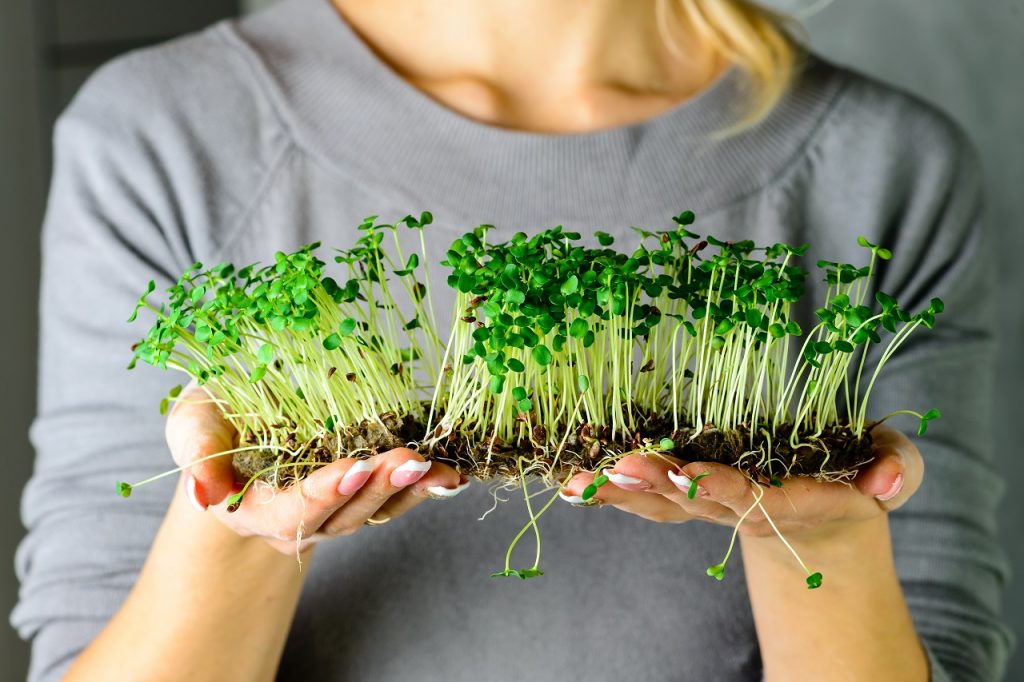
Growing your own plants can be a therapeutic experience but most of us don’t have that luxury due to lack of space. What do you do then? The answer lies in microgreens! With a little effort, you can not only add new aesthetics to your home with minimum space requirement but also enhance your health and wellbeing.
What Are Microgreens?
Microgreens are basically seedlings of vegetables and herbs. When they are grown up to 2-3 inches tall, they contain more nutrition than their grown up counterparts. They are harvested at a very early stage unlike mature vegetables or herbs. Those mini nutrient dense plants are called microgreens. Microgreens, like other indoor plants, play a vital role in providing a pleasant and soothing environment one can live, work and relax within. Microgreens can be grown from any herb or vegetable.
Some commonly grown ones include:
- Amaranth
- Basil
- Broccoli
- Coriander
- Fenugreek
- Fennel
- Garlic
- Mint
- Mustard
- Onion
- Radish
- Wheat
What Benefits Do They Provide?
- Microgreens contain 4 to 40 times more nutrients than their mature counterparts.
- They are incredibly rich in nutrients such as vitamins, minerals, carotenoids, essential amino acids, enzymes, antioxidants that boost the immune system, improve cardiovascular health, and lower inflammation.
- Expensive multivitamins, minerals and other supplements to promote health will no longer be required if we add a variety of microgreens to our regular diet. Just a few grams of microgreens can be enough to get your daily dose of essential nutrients.
- Growing microgreens at home is inexpensive, requires less space and low attendance. More so, you reap something of high nutritional value which is free from toxic chemicals and pesticides
- Microgreens give a distinctive flavor and can make any dish exotic.
How Do We Use Microgreens?
There are many ways in which you can use microgreens. Some of them include:
- Blending them in a smoothie
- Make a soup with other veggies
- Use them in a salad
- Add to lentils in Khichdi
- Use them as dressings or garnish
- Add them to flour for some tasty vegetable chapati instead of a regular one
- Use them in sandwiches, pizzas, burgers or tacos
How Can You Grow Them at Home?
Growing your own microgreens isn’t a difficult ordeal. All you need is just soil, a pack of seeds, a tray or a pot or any disposable small container.
Steps to follow:
- Take a clean container or 10×20 tray and make holes in the bottom to provide proper drainage.
- Cover the bottom with moisturized soil or potting mix, putting 1 or 2 inches of it.
- Even the surface out and make sure you don’t press the soil too hard.
- Spread the seeds over the soil and press them gently with your fingers.
- Cover the seeds with another thin layer of soil.
- Cover the container with a lid or plastic wrap and keep it in the shade so it can germinate.
- After a couple of days, your seeds will have germinated. Take the lid off and expose it to sunlight.
- Around a week after you uncover your trays, they should be ready to harvest.
They are pretty nice on pots as well as palatable on your plate. So get free of those expensive ornamental plants and get to grow these versatile ones. Growing your own plants and consuming them provides a different kind of satisfaction.
Which microgreen are you keen on growing? Let us know in the comments below! For more guidance on growing your own microgreens ask a GOQii Coach by subscribing for Personalised Health Coaching here.
#BeTheForce




very informative .. article written by a very knowledgeable health coach
I want to grow fenugreek and fennel
Dhaniya methi podhina